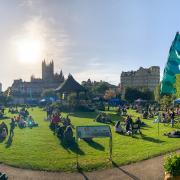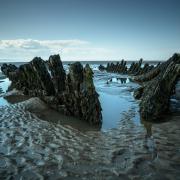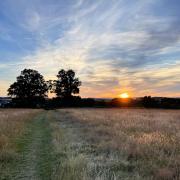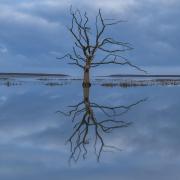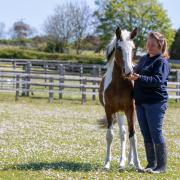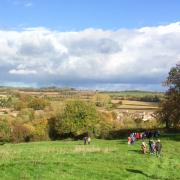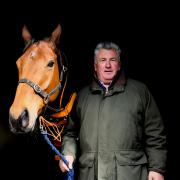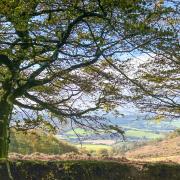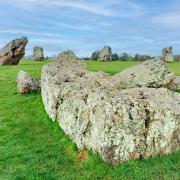Silvia Dimitrova's icons can be found in Wells Cathedral and churches around the county. She always knew she wanted to be a painter. "As a child I was captivated by the light that came from icons and the way their gaze followed you as you moved," ...
Somerset based icon artist Silvia Dimitrova chats to Robert Hesketh
Her imagination was fired early; both her parents were professional artists and her grandmother an actress and writer, who told wonderful stories. Naturally, religious icons were part of her childhood too. In her native Bulgaria, every Orthodox home has the Mother and Child and often other icons too, and this ancient Byzantine art is central to every Bulgarian church.
"The images of these very serious people fascinated me. They obviously had a message in their eyes, which I did not fully understand at the time, but I knew the icon is meant to talk to you - it's like a window into the world of God. As I grew up, I became fascinated with the technique of painting them too."
Since icons were first painted in the 6th century, the technique has not changed and neither have the materials - wood, sometimes covered with canvas. When the gesso (the white base) is dried and sanded, gold leaf is added, giving them a special aura. Only then is the icon ready for the egg tempera paint. Finally the varnish (resins dissolved in turpentine) is applied.
Painters follow tradition in this instructive art, where each colour and symbol has a specific meaning; Christ always wears blue, the colour of heaven and royalty.
"The icons first developed to tell Bible stories, when many people were illiterate," explains Silvia. "When you paint an icon you work from dark to light, not the usual way with painting. It is the Byzantine idea of catharsis. An icon looks awfully dark and grim at first. You build up the layers of paint until you come to the light and the icon comes to life... it's a wonderful process."
After graduating from art school at 19, Silvia found her artistic direction in iconography: "I started at home with my parents' help," she continues. "They had a lot of knowledge and experience to give me. After a year with them, I went to the icon master who had taught my mother. I was his apprentice for a year. He was an old man by then and his sight was growing dim, so he got me to paint the most intricate parts of the icons. I loved this. It was very good practice and helped me to be good at detail."
Silvia was invited to exhibit her work at the Alexander Nevsky Cathedral in Sofia. She also had a solo exhibition in Paris in 1997, the first of a series of successful exhibitions in France and later Britain. A new chapter in her life opened in 1999, when she was commissioned to paint an icon of Saint Benedict for Downside Abbey.
Silvia stayed at Downside to paint it in situ. She'd never been to England before, so she thought it would be a lovely way to combine work with learning about a new country. That summer she met Simon Potter, house master and design and technology teacher.
Silvia returned to England to paint the Stations of the Cross for Wells Cathedral (their project for the Millennium). She and Simon were married there.
"Simon is a very artistic person, but at the moment he is focused on helping me. I was very lucky to find such a clever man. We work as a team. He's a major part of my work - he prepares all my panels, frames and backings. I'd be completely lost without him at exhibitions, and with websites and promotions. I'm afraid he doesn't have much rest after school!"
Encouraged by Simon, Silvia began painting secular subjects too. The two are complementary: "Icons strongly influence my secular paintings, which gives them a special look. Although they use the same technique as the icons, they are quite different in some ways. Icons are classical, an art form unchanged over time - probably they are the only form of art that passed untouched through 15 centuries.
"But with the pictures I am free to use my imagination and experiment with colours. Although I have always loved icon painting, I always had an urge to produce something that is mine. These pictures came to life after I moved to Somerset and married Simon. They are mainly on the theme of love, celebrating love and beauty. Art is about celebrating beauty more than anything else, that and telling a story."
How does Silvia see her work developing in the future?
"I'm never going to abandon my icons because I love them. I am an icon painter and Downside Abbey is a superb place to paint them. Not only is the atmosphere right, but the monks are on hand to advise on the saints' lives.
"We wait and see with my modern paintings. I pick up on things all the time and include them in my work, inevitably changing it. I find inspiration in the places I visit, in books and stories too."
From Easter 2008 a new commission of Silvia's can be seen in the chapel at The Bishop's Palace in Wells. Simon has prepared the five leaf-shaped panels for her, and she has started sketching the designs on the theme of reconciliation.
Meanwhile, her icons can be seen at Wells Cathedral (the Stations of the Cross) and in three churches: St Benedict's, Downside School; St Benedict's, Stratton-on-the-Fosse, and St Adhelm's, Chilcompton. From 21 November to 12 December, some of her icons will be part of a special exhibition of contemporary iconographers at Wallspace, All Hallows' Church, London Wall. You can also see some of Silvia's work at Mary Cruz Antiques, Broad Street, Bath from now until Christmas. BY ROBERT HESKETH
For more information on Silvia Dimitrova visit www.silviadimitrova.co.uk.





